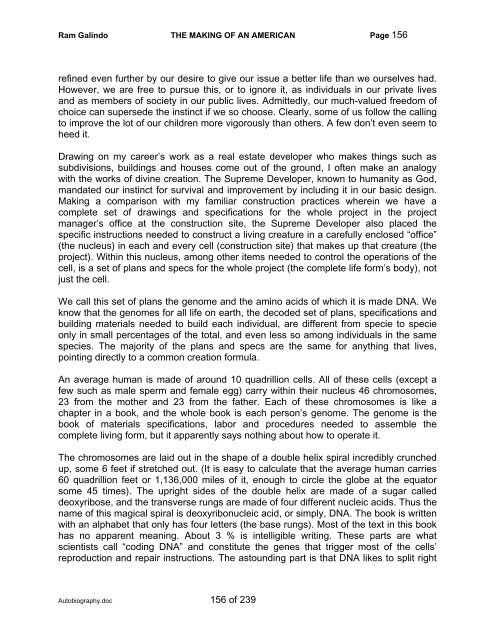Autobiography - The Galindo Group
Autobiography - The Galindo Group
Autobiography - The Galindo Group
You also want an ePaper? Increase the reach of your titles
YUMPU automatically turns print PDFs into web optimized ePapers that Google loves.
Ram <strong>Galindo</strong> THE MAKING OF AN AMERICAN Page 156<br />
refined even further by our desire to give our issue a better life than we ourselves had.<br />
However, we are free to pursue this, or to ignore it, as individuals in our private lives<br />
and as members of society in our public lives. Admittedly, our much-valued freedom of<br />
choice can supersede the instinct if we so choose. Clearly, some of us follow the calling<br />
to improve the lot of our children more vigorously than others. A few don’t even seem to<br />
heed it.<br />
Drawing on my career’s work as a real estate developer who makes things such as<br />
subdivisions, buildings and houses come out of the ground, I often make an analogy<br />
with the works of divine creation. <strong>The</strong> Supreme Developer, known to humanity as God,<br />
mandated our instinct for survival and improvement by including it in our basic design.<br />
Making a comparison with my familiar construction practices wherein we have a<br />
complete set of drawings and specifications for the whole project in the project<br />
manager’s office at the construction site, the Supreme Developer also placed the<br />
specific instructions needed to construct a living creature in a carefully enclosed “office”<br />
(the nucleus) in each and every cell (construction site) that makes up that creature (the<br />
project). Within this nucleus, among other items needed to control the operations of the<br />
cell, is a set of plans and specs for the whole project (the complete life form’s body), not<br />
just the cell.<br />
We call this set of plans the genome and the amino acids of which it is made DNA. We<br />
know that the genomes for all life on earth, the decoded set of plans, specifications and<br />
building materials needed to build each individual, are different from specie to specie<br />
only in small percentages of the total, and even less so among individuals in the same<br />
species. <strong>The</strong> majority of the plans and specs are the same for anything that lives,<br />
pointing directly to a common creation formula.<br />
An average human is made of around 10 quadrillion cells. All of these cells (except a<br />
few such as male sperm and female egg) carry within their nucleus 46 chromosomes,<br />
23 from the mother and 23 from the father. Each of these chromosomes is like a<br />
chapter in a book, and the whole book is each person’s genome. <strong>The</strong> genome is the<br />
book of materials specifications, labor and procedures needed to assemble the<br />
complete living form, but it apparently says nothing about how to operate it.<br />
<strong>The</strong> chromosomes are laid out in the shape of a double helix spiral incredibly crunched<br />
up, some 6 feet if stretched out. (It is easy to calculate that the average human carries<br />
60 quadrillion feet or 1,136,000 miles of it, enough to circle the globe at the equator<br />
some 45 times). <strong>The</strong> upright sides of the double helix are made of a sugar called<br />
deoxyribose, and the transverse rungs are made of four different nucleic acids. Thus the<br />
name of this magical spiral is deoxyribonucleic acid, or simply, DNA. <strong>The</strong> book is written<br />
with an alphabet that only has four letters (the base rungs). Most of the text in this book<br />
has no apparent meaning. About 3 % is intelligible writing. <strong>The</strong>se parts are what<br />
scientists call “coding DNA” and constitute the genes that trigger most of the cells’<br />
reproduction and repair instructions. <strong>The</strong> astounding part is that DNA likes to split right<br />
<strong>Autobiography</strong>.doc 156 of 239


